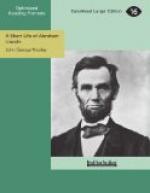Thomas Lincoln’s arrival was in the autumn of 1816. That same winter Indiana was admitted to the Union as a State. There were as yet no roads worthy of the name to or from the settlement formed by himself and seven or eight neighbors at various distances. The village of Gentryville was not even begun. There was no sawmill to saw lumber. Breadstuff could be had only by sending young Abraham, on horseback, seven miles, with a bag of corn to be ground on a hand grist-mill. In the course of two or three years a road from Corydon to Evansville was laid out, running past the Lincoln farm; and perhaps two or three years afterward another from Rockport to Bloomington crossing the former. This gave rise to Gentryville. James Gentry entered the land at the cross-roads. Gideon Romine opened a small store, and their joint efforts succeeded in getting a post-office established from which the village gradually grew. For a year after his arrival Thomas Lincoln remained a mere squatter. Then he entered the quarter-section (one hundred and sixty acres) on which he opened his farm, and made some payments on his entry, but only enough in eleven years to obtain a patent for one half of it.
About the time that he moved into his new cabin, relatives and friends followed from Kentucky, and some of them in turn occupied the half-faced camp. In the ensuing autumn much sickness prevailed in the Pigeon Creek settlement. It was thirty miles to the nearest doctor, and several persons died, among them Nancy Hanks Lincoln, the mother of young Abraham. The mechanical skill of Thomas was called upon to make the coffins, the necessary lumber for which had to be cut with a whip-saw.
The death of Mrs. Lincoln was a serious loss to her husband and children. Abraham’s sister Sarah was only eleven years old, and the tasks and cares of the little household were altogether too heavy for her years and experience. Nevertheless, they struggled on bravely through the winter and next summer, but in the autumn of 1819 Thomas Lincoln went back to Kentucky and married Sally Bush Johnston, whom he




